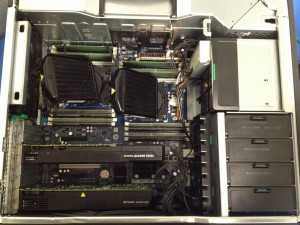Outside of the GPU pass-through video project I’ve made, I began working with XenApp 6.5 back when it was still in beta. It’s been almost 2 years now, but I still remember the initial setup and testing of the HDX capabilities.
I’ll admit I should have taken more time to look behind the curtains and reviewed what resources were being used and how much, but I was so smitten with just the idea of moving my CAE (Computer Aided Engineering) apps to the cloud that I overlooked some very important information.
In the third video of the series I had to do some back end research on XenApps capabilities and the GPU driver calls of my software. As I found out AutoDesk is the only major CAE player that uses DirectX and everyone else (Solidworks, SIEMENS NX, Catia, Pro-E/Creo, ArcGIS) uses OpenGL for their graphics calls. I also realized that the OpenGl graphics calls were being handled by the CPU in the XenApp environment and not the nice fancy Nvidia GPUs.
I was able to run the software, but in a limited graphical capacity. The larger the file, more complicated the assemblies, or the higher the realism was turned on the more you could see the separation in the armor.
I went back to the various Citrix forums and did some digging. One thread:
http://forums.citrix.com/thread.jspa?threadID=295641
had a poster (Thomas Kotzing) that mentioned Citrix had some level of OpenGL support in the XenApp 6.5 beta but removed it and coded into XenDesktop. His web site says that he doesn’t work for Citrix so I cannot verify what he says. If it is true, I think it was a poor move on Citrix’s part.
In looking at the new products from Citrix (Project Avalon) and Nvidia (The GRID), I get the sensation that the Virtual Desktop is getting more attention than the Virtual Apps are nowadays. The systems admin inside of me (who eerily sounds like Gollum) keeps mumbling that from our perspective virtual desktops are the same as physical desktops. You still have to format the GUI to some company standard, and generate the “Golden Image” to be passed around. I already do that for my physical systems. @Citrix and @Nvidia why can’t I get the same level of service for my V-apps as you guys are making for V-desktops?
I mentioned this to a colleague at Nvidia, and while they couldn’t make any official statement, they did say that 2013 still has a lot to offer.
The Nvidia GPU Tech Conf. is in March so maybe something will come from that. We’ll see. For now, I still recommend grabbing some hardware if you got it, a demo license from Citrix, and testing out some of your own files to see what works and what crashes.
Cheers.


